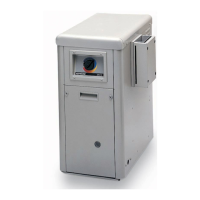The heat exchanger in your Hayward pool heater is made from the highest quality of copper materials. The premium materials
and the exacting processes used in the manufacture of the heat exchanger is state of the art in pool heater design and manu-
facture. Yet, it remains vital that the heat exchanger be protected from damaging or corrosive chemicals, insufcient water ow
or improperly balanced water chemistry. Heat exchanger damage or failure resulting from improper ow, improperly balanced
pool water or the improper addition of sanitizers into the water is NOT covered under the terms of your warranty.
The following factors are critical to heat exchanger protection. Follow these guidelines to help prevent pre-mature damage or
failure to your heater and heat exchanger.
1. WATER FLOW THROUGH HEATER
Water must be owing through the heater at the minimum rated flow rate during operation. Check that the pump is operating
and the system is lled with water and purged of all air prior to starting the heater. The minimum rated ow rate for your heater
is 20 GPM.
2. POOL/SPA WATER CHEMISTRY
The chemistry balance and mineral content of swimming pool water changes daily due to the addition of pool and sanitizing
chemicals, bather loads, rain, runoff and the amount of sun - to name a few. Improper chemistry balance and mineral content
can cause scaling and deposits to form on pool walls, in the ltration system, in the heat exchanger tubes and additionally can
promote corrosive action to all metals in the water path. Changing spa water regularly and maintaining the correct chemical
balance in your pool/spa will keep the pool/spa safe and sanitary, and will help protect the heat exchanger. Use a 4-way pool/
spa water test kit to check your water frequently (at least weekly). Use the following guidelines to help protect your heater’s
heat exchanger:
Recommended
Level
Effect of Low Levels Effect of High Levels
Chlorine
1 - 3 ppm
Bromine
2 - 4 ppm
pH
7.4 - 7.6
corrosive to heat exchanger,
swimmer irritation
cloudy water, scaling of heat exchanger,
reduced sanitizer effectiveness
Total Alkalinity
80 - 120 ppm
corrosive to heat exchanger,
large fluctuations in pH
scaling of heat exchanger
Calcium Hardness
200 - 400 ppm corrosive to heat exchangerscaling of heat exchanger
Salt
2700 - ppm poor salt chlorinator performancecorrosive to heat exchanger
hazy water, algea growth,
bacteria causing infections
swimmer irritation, bleaching of clothes/hair,
corrosive to heat exchanger
5000
3. SKIMMER CHLORINATION
Placing chlorine or bromine tablets directly into the skimmer may result in high chemical concentrations owing through the
heater. DO NOT place chlorine or bromine tablets in the skimmer.
4. CHLORINATOR INSTALLATION
Chlorinators must be installed downstream of the heater, and a check valve must be installed between the heater and chlorina-
tor to prevent high chemical concentrations from back owing into the heater.
5. BYPASS
Until water chemistry is properly balanced, and if your piping has a bypass valve installed for the heater, open the bypass so
that corrosive and potentially damaging water will not ow through the heater and therefore the heat exchanger. Close the
bypass valve once the water is properly balanced. Failure to close the bypass valve when attempting to operate the heater
will result in extensive damage to the heat exchanger. Ensure water ow through the heater is restored before operating the
heater. A bypass feature is also advantageous for service needs and for the ability to remove the heater from the water path
when not heating. Refer to Figure 2 in the installation manual for further information.
Failure to Maintain Proper Water Chemistry May Cause
Premature Heat Exchanger Damage or Failure
WARNING:
2

